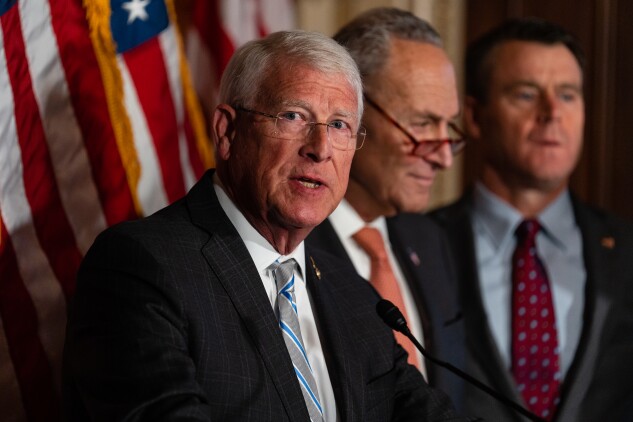- GOP chairmen of Armed Services lay out top priorities for 2025
- Rogers, Wicker want defense spending to be close to 5% of GDP
The GOP chairman of the House Armed Services Committee is aiming to “significantly” increase defense spending this year, and he has a new Senate counterpart who also wants to bridge intraparty divides to make that a reality.
Defense spending should be at the “minimum threshold” of 4% of US gross domestic product, Rep.
Congress has been wrestling with how the US should prepare for possible future conflict with China and address weaknesses in the defense industrial base supply chain exposed by wars in Ukraine and the Middle East.
But increasing Pentagon spending may not be an easy feat within the Republican conference where factions, particularly in the House, want to see cuts to government spending. Still, Rogers will be joined by his Senate Armed Services Committee counterpart,
The minimum threshold under Rogers’ plan would push defense spending to nearly $1.2 trillion. National defense spending is capped at $895 billion for the current fiscal year, with $850 billion going to the Pentagon.
Trillion-Dollar Defense Budget
Rogers said he would seek to address defense spending as part of the budget reconciliation process to wear down some of the resistance in his restive caucus.
“This is going to be a multiyear process, we are so far away from 4%,” Rogers said. “I want to start in reconciliation, but then we will have to do it in the regular process every year,” he added, referring to the annual defense authorization and appropriations bills.
Rogers said he would be working closely with Wicker.
“We’ll be singing off the same sheet of music,” Rogers said.
Austin Pushes for Almost $1 Trillion in Defense Spending
Wicker Proposals
Wicker has already proposed increasing the defense budget in a bid to gradually raise US military spending to 5% of the country’s gross domestic product, surpassing $1 trillion.
Wicker last year had also pushed to increase the defense topline by $25 billion in fiscal 2025, but was unsuccessful in including the boost in the final defense authorization bill. Lawmakers have yet to write the spending bill for this fiscal year and the Senate Appropriations Committee has already proposed a $25 billion boost in defense spending.
Congress Leaders to Decide on $25 Billion Boost to Defense Bill
Under Wicker’s original proposal, national defense spending would have risen to $950 billion this fiscal year and then steadily increase to reach 5% of GDP—about $1.5 trillion under current GDP levels of $29.4 trillion, using the latest quarter available of Bureau of Economic Analysis data.
BGOV Bill Analysis: Fiscal 2025 Defense Authorization Agreement
Wicker has already made his case with the incoming Trump administration, saying in a recent interview that the president “needs a higher topline and I have expressed that to the new national security adviser, as well as various nominees and to the vice president-elect.”
“We enter the new year in an extremely volatile situation, as radical Islamic terror rages and our four principal adversaries conspire to threaten the United States,” Wicker said in a statement after becoming chairman of the Senate Armed Services Committee. “The American people want peace, and the only way to achieve that is through strength. I look forward to working with both President Trump and my colleagues to rebuild and reform the U.S. military.”
Democratic Partners
Wicker would have a partner in top Democrat
Reed also said he wants to ensure that Congress continues support of the war in Ukraine—a complicated political ask in the current GOP-run House and Senate. Even so, Reed would have some strong allies in Wicker, Rogers and former Senate Republican Leader Mitch McConnell (Ky.), who took the reins of the Appropriations Defense subcommittee this year.
Innovation and Weapons
The Republican and Democratic leaders of the armed services panels are all on the same page when it comes to innovating defense technology, especially in the areas of drones, missile-jamming, critical munitions production and machine learning, as Rep.
Rogers said there are three major, troubled Pentagon weapons programs that “are dominating” his thoughts:
“They are big ticket items and they are absolutely essential,” Rogers said in the interview. “It’s not like we can get rid of one of them. We got to fix them and they are all going to be expensive.”
To contact the reporter on this story:
To contact the editors responsible for this story:

